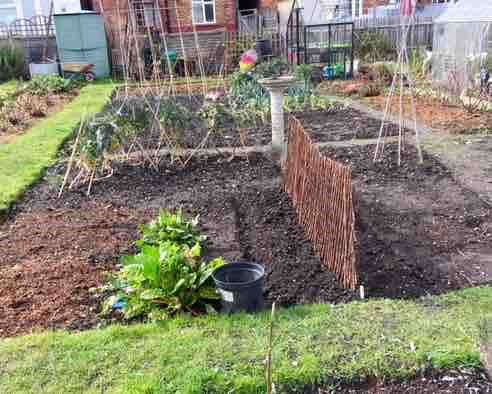
Maintaining soil and structures and planning ahead
- Although weather is warmer, continue to listen for forecasts of frost warnings and cover vulnerable plants at night. Delay planting out cold sensitive plants if frosts are forecast.
- Weed ‘defensively’; remove weeds before they flower to avoid seeding.
- Continue to keep grass paths manageable by regular cutting.
Draw up soil around the base of peas and broad beans to support them and increase the rooting area. - Clean greenhouse glass to improve light levels
On sunny days ventilate the green house by morning opening and close late afternoon to conserve the heat. - Earth up early potatoes when they have made 8” growth.
Plan and prepare planting holes for squashes, adding well-rotted manure. - Build frames for climbing beans.
Sowing and Growing
- Sow indoors or in the greenhouse Brussels sprouts, cabbage, early leeks, cucumbers, courgettes, peppers and sweet corn. Sow tomatoes for outdoors.
- Sow herbs; dill, fennel, oregano and thyme, parsley from seed.
- At the end of the month sow tender vegetables indoors, such as runner beans, squash and pumpkins.
- Watch out for signs of damping off in seedlings which can be caused by sowing in cold, wet soil with poor drainage and air circulation and worsened by overwatering. A light covering of vermiculate reduces the problem.
- Direct sow broad beans and early peas.
- Make successional sowings of beetroot, Swiss chard, lettuce, radish, summer spinach, spring onions, lettuce, parsnips and turnips.
- Thin out germinated seedlings and hoe between rows.
- Direct sow early varieties of carrot when the ground has warmed up. To avoid attack from carrot fly, either sow 18” above ground level or cover with insect mesh.
- Sow annuals to attract pollinating insects such as nigella, single flowered marigolds, comos, Californian poppies.
- Direct sow sweet peas.
- Second early and maincrop potatoes should be planted by the end of the month.
- Once tomatoes have their first true leaves, plant them deeply into individual pots
- Water crops regularly in dry weather.
- Plant out autumn-sown sweet peas.
- Finish planting shallots.
- Plant soft-neck garlic.
- Plant up new asparagus and globe artichoke beds.
- Cover radishes and turnips with horticultural fleece to protect against flea beetle.
- Use fleece to protect blossom of trees such as pears if frost is forecast.
- Net strawberries against bird attack.
- Watch out for early aphid attacks. Early action by manually removing these or hard- spraying with water can reduce likelihood of damaging infestations.
- Feed roses with rose feed.
- Feed soft fruit with a general purpose fertilizer.
- Pick and destroy yellowing leaves of brassicas infected with downy mildew.
Harvesting
- Harvest rhubarb by pulling a few stalks at a time. Put the leaves on the compost heap.
- The first cutting of asparagus is traditionally made after St George’s Day, 23rd April and the last cutting on the longest day, 22nd June.
Pruning
- Once leaf buds open, start formative pruning of stone fruit trees such as plum and cherry.
- Pinch out laterals on grape vines to leave one every 30cms and tie in selected shoots.
Gardening for wildlife
- Divide or cut back pond marginal plants.
- Prepare a fine tilth before sowing a wildflower meadow patch of cornfield annuals to attract pollinating insects.
